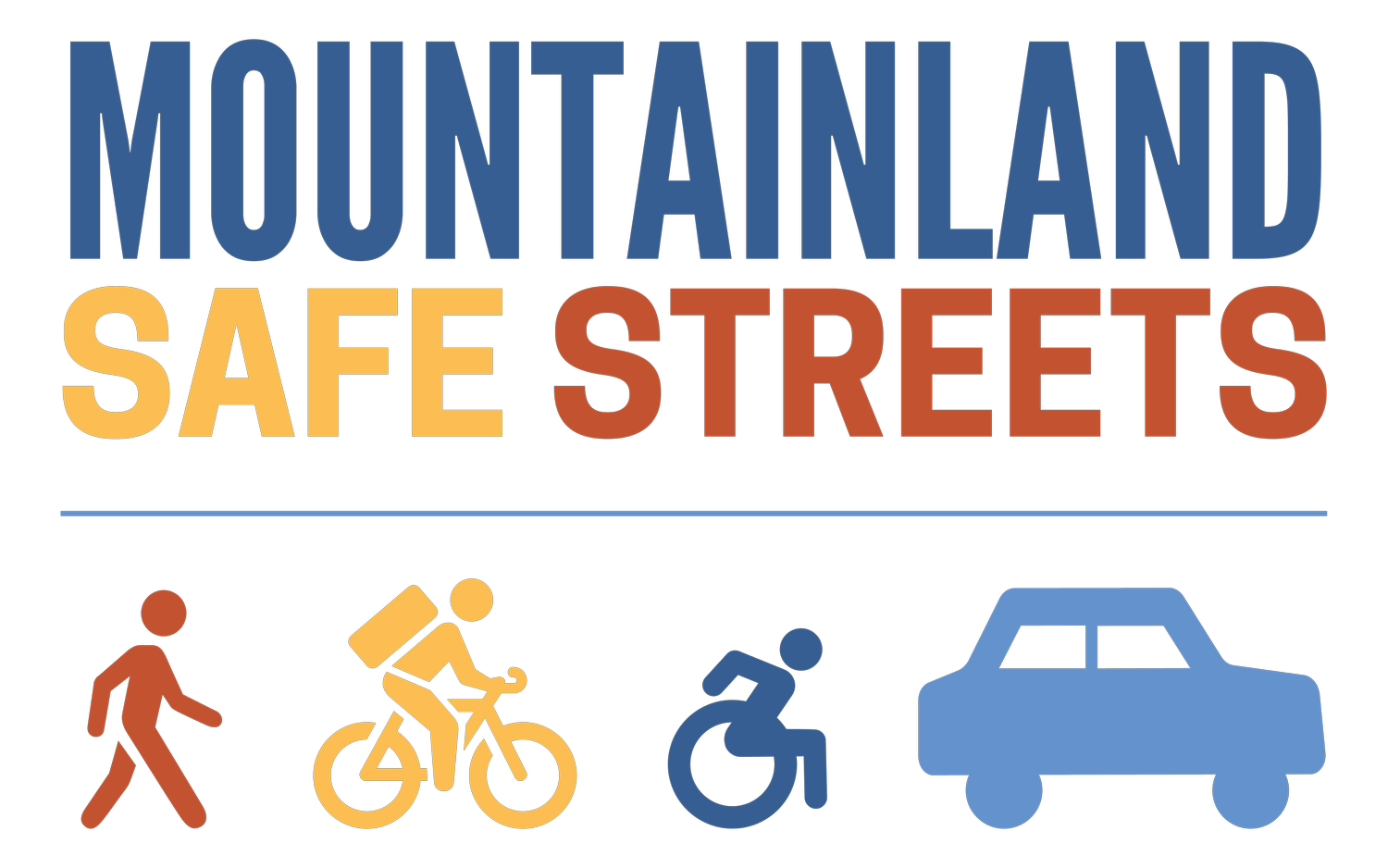
Safe Streets for All
Focusing on road safety in Utah, Wasatch, and Summit Counties
We have spent the last eight months developing a Safety Action Plan to reduce the numbers of serious-injury and fatal crashes involving all roadway users in Summit, Utah, and Wasatch Counties.
As part of the planning process, we held a series of open houses for the public to learn about the project and give input on a proposed list of strategies and transportation safety projects. The information shared at each open house is linked below.
Check out the MAG Proposed Projects map!
OVERVIEW
Throughout the United States and Utah, traffic fatalities have been trending up over the last decade, including pedestrian and bicycle crash fatalities.
To improve safety for all roadways users (drivers, pedestrians, cyclists, people who use scooters, mobility devices, etc.), the Mountainland Association of Governments (MAG), which develops transportation policies and guidance for Summit, Utah, and Wasatch counties, is developing a Safety Action Plan that will have a lasting change on safety culture in these communities.
A Safety Action Plan is the foundation of the US Department of Transportation Safe Streets and Roads for All (SS4A) grant program and is comprised of multiple components, including an official public commitment, a data-driven safety analysis, public engagement and collaboration, equity considerations, policy/process changes, and strategy and project selection. A Safety Action Plan is required to apply for funding through an SS4A Implementation Grant for a specific project.
Ultimately, the Plan will result in a series of transportation improvement transportation projects that MAG, and/or cities within its jurisdiction, can submit to the United States Department of Transportation to gain funding for implementation.
FAQs
-
Safe Streets for All (SS4A) is the U.S. Department of Transportation’s (USDOT) comprehensive approach to significantly reducing serious injuries and deaths. The approach requires partnering with community stakeholders to commit to a local goal of moving closer to zero roadway fatalities and serious injuries. Central to the effort is the development of a Safety Action Plan to identify priority actions and changes to target the most significant and urgent problems.
-
The Mountainland Association of Governments (MAG) has received a federal SS4A grant to develop a Safety Action Plan for Utah, Wasatch and Summitt Counties that will outline a holistic, well-defined strategy to prevent roadway fatalities and serious injuries in each county.
Currently, the team is analyzing crash data from throughout the participating MAG counties to understand what types of crashes are happening most frequently and where they are happening. This information will help designate a High Injury Network showing the areas with the greatest concentrations of high-severity crashes. This data gives the team information needed to determine the priority locations for implementing safety improvement projects and what kinds of projects are likely to reduce crashes at these locations. -
It means that specific locations or street corridors will be identified which are unsafe and a plan on how to mitigate the hazards will be put into place. This is just one step in the process to improve safety within Utah, Wasatch, and Summit Counties.
-
The data helps agencies move towards zero fatalities and serious injuries. It identifies crash hot spots, emphasis areas (where crashes of several types occur often), and vulnerable road users (pedestrians, cyclists, and wheelchair users). An analysis of equity will occur to highlight underserved areas in each of our communities and how these populations utilize the transportation network.
-
Policy and process changes
To enact real change, the Safety Action Plan must position MAG and its local member governments for successful and easy implementation of safer streets. An evaluation of existing frameworks against national best practices and identifying inconsistencies or barriers to implementation will occur. The plan will be heavily influenced by the understanding and information gained through stakeholder and community engagement and data analysis; as such, the findings from those tasks will influence policy, programmatic, and procedural recommendations to eliminate barriers to safer streets.The development of a regional safety countermeasures toolkit will occur. This tool kit will identify impactful countermeasures, connect them to prevailing crash types within the MPO/RPO, and detail design and implementation considerations. The toolkit could be adopted by member governments or used to inform local design standards or guidelines changes.
Strategy and project selection
The project team will identify projects and treatments to address localized and systemic safety issues enumerated through data analysis. We will utilize FHWA Proven Safety Countermeasures, Highway Safety Manual Crash Modification Factors, and cost/benefit evaluation to select the most effective treatments.
Additional groups will be brought in to help refine project selection. We will consult with respective local government staff for project identification and selection. We understand that most safety projects will be implemented at the local level and recognize that if local governments are not on board with recommendations, the projects will never move outside the pages of the report. Additionally, the engineering design and cost estimate team will be integrated early to provide insight regarding feasibility and practicality for project selection and get a head start on the concept report process.
Plan development and adoption
The project team will develop comprehensive Safety Action Plans meeting SS4A requirements for self-certification for the MAG (MPO in Utah County and RPO – Wasatch Back in Wasatch and Summit Counties). The documents will clearly identify the projects and programs—both short-term and long-term—that can be implemented to establish a safe systems approach and reduce fatal and serious injuries. Because of the visual nature of the crash analysis, the project team will produce companion online materials like our story maps as done for other cities which improves the understanding of the project for officials as well as the public. We will present each Safety Action Plan to the respective MAG MPO Board and Wasatch Back RPO Board for approval.
-
A series of meetings with the MPO and RPO are currently being held. Online open houses were held in 2023 and the recordings can be seen below on each County’s page on this website (navigate to the top to access). This website will be kept up to date during the project's duration. An online survey was conducted and the results can be viewed here.
We currently have an interactive map available to gather feedback from Utah, Summit, and Wasatch Counties’ residents and visitors. You can access it in the next section called “Comment Map.”
There will be in-person public meetings in each county and information about these meetings will be displayed on this website.
Pop-up events will be held in each of the three counties. These events are to promote the project and gather public input. These may occur at community events and festivals, biking/walking trails, rec centers/games, or setting up a canopy and a-frame signs to engage passersby in busy areas. There will be a newsletter about the project to provide updates, social media posts on Facebook and Twitter, a project email and a hotline will all be available to the public.
Additionally, interactions between stakeholders will be collected and added to a database for transparency and documentation purposes.
Review the Survey Results
COMMENT MAP
We welcome your input and invite you to share your thoughts on location-specific transportation concerns in Utah, Wasatch, and Summit Counties. To provide your feedback, kindly click on the link below to access our comment map. Thank you for contributing to the improvement of transportation in your community.
SCHEDULE
The first phase of the Safety Action Plan process is underway and is expected to result in a list of initial projects in June 2024. There is no date yet for when these projects will be built, but the first round of funding will take place in 2024.

SAFE STREETS AND ROADS FOR ALL (SS4A) GRANT PROGRAM
The Safe Streets and Roads for All (SS4A) discretionary program was created under the Bipartisan Infrastructure Law (BIL) with a dedicated budget of $5 billion spanning from 2022 to 2026. This initiative allocates funds to support regional, local, and Tribal projects through grants, aiming to reduce fatalities and severe injuries on roadways. Notably, there is still over $3 billion accessible for upcoming funding rounds. To find out more information click on the button below.
SHARE YOUR THOUGHTS
The project team will be engaging with the community throughout the life of the project. We anticipate doing in-person surveys in different locations throughout Summit, Utah, and Wasatch counties this fall and will be holding virtual open houses in December. For more details, please subscribe for updates via email.
We will send periodic updates on project progress, opportunities to provide input, public events, and the final list of identified projects. Reach out to the team with comments and questions.
Phone
385-855-3292
safestreets@mountainland.org






